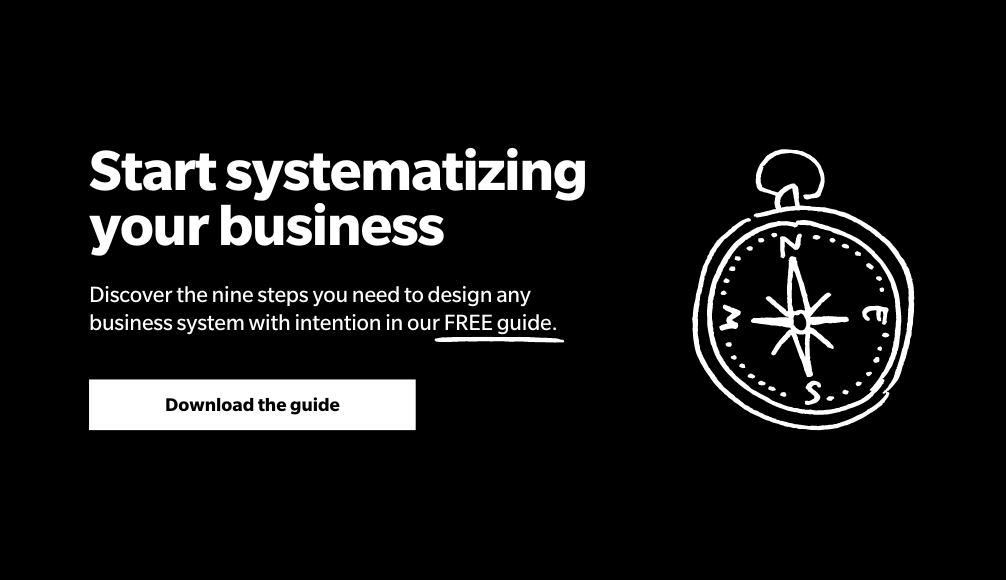Without documentation, “great business systems” are only rough ideas about the way you do things in your business. And all your tasks, functions, processes and procedures—the way that you and your staff habitually do everything—are nothing more than good intentions.
In other words, you need to write them down.
You may resist that idea. But how often do you find yourself telling your employees how to do something? Again and again and again? What if you didn't have to do that anymore? What if they just knew?
As a coach, it's not uncommon to hear my clients ask, "Why can't people just get it?"
You hire people for their skills and experience and think they should be able to figure it out, right? And the truth is, they will. They'll create the systems that run your business either by accident or by design. But they won't be your systems unless you transfer the knowledge of how you want things done by creating and documenting those systems yourself.
The system for systems
The work of developing effective systems isn’t truly complete until they're captured, written down and made readily accessible in an effective and systemic fashion. It shouldn’t surprise you that at EMyth we have a system for that called the System Action Plan. You should be using something similar as you develop and build your business and your business functions.
We work with our clients to help them develop a system to effectively identify the documentation work they should be doing–and how to best structure and prioritize that work.
How do you write a good business system?
You need to have a plan for effectively documenting all the key routines you have in your business. And you need to find a balance that works for you.
Since the work of company systems documentation will be taking place concurrently with all of the regular daily tasks and operations of your business, it's vital to have a well thought-out strategy. Allowing sufficient time and resources from the start will prevent missteps down the road.
Here's an example of an approach that's worked well for many of my clients:
The five steps for documenting your systems
You need to have a plan for effectively documenting all the key routines you have in your business. And you need to find a balance that works for you.
Since the work of systems documentation will be taking place concurrently with all of the regular daily tasks and operations of your business, it's vital to have a well thought-out strategy. Allow sufficient time and resources from the start to prevent missteps down the road.
Here's an example of an approach that's worked well for many of my clients:
- Identify your key systems. One approach that our clients use is to review their business functions by separating the operations into categories we call the Seven Essential Systems. You can approach this by considering one department or operational unit of your business at a time. List all of the key tasks, functions and procedures you can think of. Enlist the help of your employees. The goal is to be as complete and comprehensive as possible.
- Draw up a “systems diagram”. Create a diagram of all the systems in your business: existing systems and those that need to be created. Remember to identify all the systems that comprise your business, including systems you don’t have yet, but will need in order to achieve your vision for your business. Typically, most of your systems will be in these three essential business processes: client fulfillment, lead conversion and lead generation. You’ll also need to identify your administrative, human resources, finance and even information technology systems.
- Make a prioritized business systems listing Based on your systems diagram, simply list all the systems on a spreadsheet that will become a working document for planning and controlling business development efforts companywide. This will serve as the basis of your “Master To Do List” for systems documentation. Prioritization is often determined by the impact of a given system: how great is its impact on your customers and how great is the impact on your business, your bottom line?
- Assign accountabilities for documenting the systems. It's quite unlikely that you'll have the time, inclination, or even the ability to thoroughly document every system yourself. A significant part of the strategy in this plan is in delegating some or most of this function to your manager(s) and/or staff. And keep in mind that they too will have to complete this work while continuing to perform their other daily functions. So establishing clear target dates and benchmarks is a critical part of the success of this strategy. This won’t happen overnight. Focus on the key systems that, once implemented, might have the greatest impact on improved workflow. Do that and you’ll gain even more time to dedicate to systems-development and strategic thinking.
- Develop and use a standard approach for documentation. At EMyth we provide our clients with a System Action Plan. It's important that you provide your staff with a standard method for documentation in order to make sure all your systems are represented consistently. So, it's essential to start your team off with some samples—supported by training and timely feedback—to avoid wasted time and unnecessary frustration.
Not the holy grail
Now that you have an idea for how to document your systems, there’s a very important caveat.
Good systems—effective, dynamic business systems—are utterly essential to building and sustaining a great business. But merely having those systems is not the solution for a dysfunctional business.
We’ve said it before but it bears repeating: people are the power behind the systems. The systems are their levers, not their replacements.
Your business has enormous potential because you and your people have enormous potential. And when your people have the freedom to find the most effective way to complete their job, not only will they take pride in their work, they’ll never stop making the systems better.
Want to learn more about developing systems in your business? Download our Systems Guide.





Comments